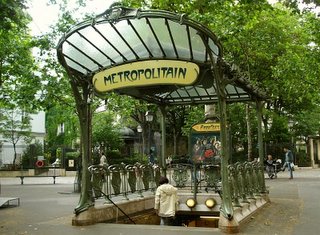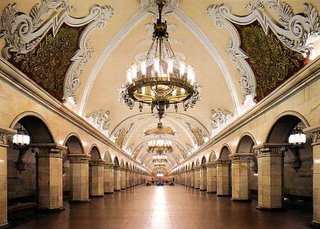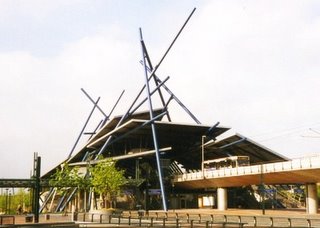Most subway systems are unfortunately quite dull from an aesthetic point of view. The stations along the Bloor-Danforth Line in Toronto, for example, look more or less the same, except for the colours of the tiles. On the other hand though, there are cities that work hard to foster arts and good architectural designs in their underground transit systems. Some of these subway systems act as the city's art galleries, museums, and even aquariums. These user-friendly, aesthetically pleasing stations have been said to help improve ridership and to reduce vandalism and crime. To no one's surprise, most of these artistic subway systems are found in Europe. Check out some of the ones that I've found:
 1) Stockholm, Sweden
1) Stockholm, SwedenKnown as the World's longest art gallery, art has been integrated in every single one of Stockholm's subway stations since it opened in 1950. Most stations have been left as rock caverns, which gives them an authentic, ruggish look. Together with special lighting, these stations are not just transit stops, but a master piece of art.
This is T-Centralen Station, one of the busiest stations in Stockholm. Doesn't this beat the tiles at Yonge-Bloor?
 2) Paris, France
2) Paris, FrancePerhaps the first city to incorporate art into its subway system, Paris' Metro is best known for its distinctive art-deco entrances (this one is at Abbesses Station). Paris' metro stations are column-free vaults that look similar throughout the system. The older stations (particularly those close to tourist attractions) are better looking than others and have a more historical appeal to them. Two interesting things that I discovered when I rode the Metro system last summer on my visit to Paris: the trains run on rubber wheels, not tracks; you have to open the train doors manually! One of the cons: someone needs to do something about the smell at some of these stations...
 3) Moscow, Russia
3) Moscow, RussiaNo, you're not looking at a grand hall inside a castle! This is the platform at Komsomolskaya Station in Moscow. Opened in the 1930s, the Moscow's subway stations were designed to be grand outstanding spaces, resembling cathedrals and castles. Many of the stations have marble-clad walls and chandelier lighting. A little creepy for my taste really, but these stations were designed under the Socialist Regime of the former USSR and were intended to be "palaces for the people". Other former USSR cities, such as Kiev in Ukraine, also have similar designs for their subway stations.
 4) Bilbao, Spain
4) Bilbao, SpainInternationally known for being the home to Frank Gehry's Guggenheim Museum, Bilbao has also invested billions of dollars to improve the visual landscape of the city through public art and good architecture. Check out the glass entrance to Abando Station. The system was designed by an architect named Sir Norman Foster, who said "A tunnel dug by man through earth and rock is a very special place. Its shape is a reaction to the forces of nature and the texture of its construction bears the seal of man. This must be respected, not covered up to make the place look like any other building. One must be able to feel being underground, and make it a good, special experience."
 5) Rhine-Ruhr, Germany
5) Rhine-Ruhr, GermanyThe Rhine-Ruhr region in Germany consists of close to 30 different tram and subway (called Bahn in Germany) lines. Many of the newer stations have interesting designs, mixing different types of materials (such as wood with concrete) with lighting. My favourite is Neue Mitte Station (shown left), which was probably influenced by deconstructivist architecture. Wouldn't it be cool if they decide to redesign Yorkdale Station or Scarborough Town Centre Station in a similar fashion?
Many other subway systems in other parts of Europe have also begun to incorporate art into their station design. The new subway system in Athens for example, has Greek sculptures and statues scattered throughout. For an upcoming post though, I'll see if I can find examples of subway art and architecture in North American subway systems...

No comments:
Post a Comment